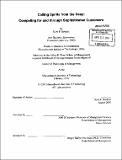Calling spirits from the deep : competing for and through sophisticated customers
Author(s)
Rockart, Scott F., 1968-
DownloadFull printable version (11.37Mb)
Other Contributors
Sloan School of Management.
Advisor
John D. Sterman.
Terms of use
Metadata
Show full item recordAbstract
This thesis explores why professional services industries stratify into hierarchies and how firms change their positions in those hierarchies over time. Essay one is entitled "Reinforcing feedback between market position and firm capabilities" and asks why Merrill Lynch succeed in building a leading investment-banking practice while rival brokerage firm Paine Webber tried and failed. The two firms' experiences and previous research are used to specify a model of competition among professional services firms. Reinforcing feedback between the nature of a firm's client work and its capabilities and intendedly rational policies lead to a hierarchy of industry competitors. Analysis of the model highlights two key elements differentiating Merrill Lynch's and PaineWebber's efforts to improve: speed in developing capabilities and discipline in accepting and rejecting client work. Essay two is entitled "You are whom you serve." It explores why hierarchies develop in professional-services industries where some firms develop stronger capabilities and execute more sophisticated client work than their rivals do. The paper develops and analyzes a game-theoretic model based on competition in the investment-banking industry. One outcome of the model is an asymmetric competitive structure where firms serve different kinds of customers, charge different prices, and earn different economic returns. That outcome is analyzed over a range of cost structures and client preferences to derive implications for firm size and economic welfare. Essay three is entitled simply "Merrill Lynch and PaineWebber." Sustained differences in profitability are evident among firms within the securities industry. Two firms, Merrill Lynch and PaineWebber, are studied to identify structural and managerial reasons why one succeeded in developing the market position and firm capabilities both sought while the other failed. The paper draws on interviews with current and former employees of the two firms and other industry experts. Interview data are checked and complemented with three decades of underwriting and two decades of merger and acquisition transaction data, annual reports, and data and commentary appearing in the industry press and academic press as well as industry association publications.
Description
Thesis (Ph.D.)--Massachusetts Institute of Technology, Sloan School of Management, 2001. Includes bibliographical references.
Date issued
2001Department
Sloan School of ManagementPublisher
Massachusetts Institute of Technology
Keywords
Sloan School of Management.